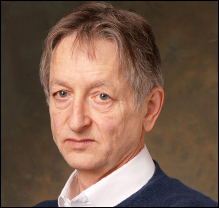
A.M. TURING AWARD WINNERS BY...
Geoffrey E Hinton

Canada – 2018
Short Annotated Bibliography
- Ackley, D. H., G. E. Hinton and T. J. Sejnowski (1985) “A learning algorithm for Boltzmann machines. Cognitive Science, 9, 147-169.
An early and highly influential description of the Boltzmann machine, a class of neural networks inspired by statistical approaches to physics. This innovation underpinned much of Hinton’s later work. - Rumelhart, D. E., G. E. Hinton and R. J. Williams (1986) “Learning representations by back-propagating errors,” Nature, 323, 533—536 and Rumelhart, D. E., Hinton, G. E., and Williams, R. J. (1986) “Learning internal representations by error propagation” In Rumelhart, D. E. and McClelland, J. L., editors, Parallel Distributed Processing: Explorations in the Microstructure of Cognition. Volume 1: Foundations, MIT Press, Cambridge, MA. pp 318-362.
Two descriptions of the new approach to training neural networks, which Hinton and his collaborators termed “back-propagation.” The Nature paper is concise and clearly argued, while the longer paper provides compelling detail. Together they helped to revive interest in connectionist approaches to machine learning. - Hinton, G. E., S. Osindero, and Y. Teh, (2006) “A Fast Learning Algorithm for Deep Belief Nets,” Neural Computation, 18, pp 1527-1554.
Returning to Boltzmann machines, Hinton and his collaborators introduced a new and efficient unsupervised learning algorithm applicable to a restricted subclass of Boltzmann machines. This demonstrated unexpected gains from the introduction of pre-trained “hidden” layers of neurons between input and output. - Hinton, G. et al. (2012) “Deep Neural Networks for Acoustic Modeling in Speech Recognition,” IEEE Signal Processing Magazine, 29, 82–97.
In this paper, Hinton partnered with co-authors from the groups working on speech recognition at Microsoft Research, Google and IBM Research to document the success they were achieving by applying deep learning to phonetic classification. This was the application that moved deep learning from experimental technique to industrial practice. - Krizhevsky, A., I. Sutskever & G. Hinton (2012) “ImageNet Classification With Deep Convolutional Neural Networks,” Proc. Advances in Neural Information Processing Systems 25, pp. 1090–1098.
This report described the design of the SuperVision program that won the 2012 ImageNet classification competition with a spectacular improvement over the performance of existing methods. Following its publication the designers of computer vision systems shifted rapidly towards deep learning methods. - LeCun, Y., Y. Bengio and G. E Hinton. (2015) “Deep Learning,” Nature, Vol. 521, pp 436-444.
A recent and accessible summary of the methods that Hinton and his co-winners termed “deep learning,” because of their reliance on neural networks with multiple, specialized, layers of neurons between input and output nodes. It addressed a surge of interest in their work following the successful demonstration of these methods for object categorization, face identification, and speech recognition.




























 THE A.M. TURING AWARD
THE A.M. TURING AWARD